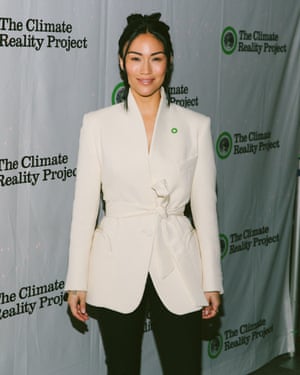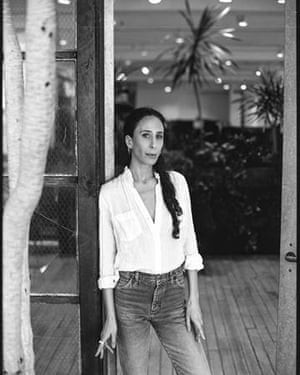Visits: 50
Over the past few years, sustainable fashion has been inching towards the mainstream. Now, given the pandemic crisis, discussion of how to create a more ethical and less environmentally damaging model for an industry that is responsible for 10% of global carbon dioxide emissions every year is more relevant than ever.
With much of the usual churn on pause because of coronavirus and many of the cracks of the industry coming to the fore – not least in Bangladesh, where garment workers are facing destitution as big-name brands cancel their orders – some people in the industry are taking this hiatus as an opportunity to reassess fashion’s direction of travel.
From a change in consumer attitudes to a slowing down of the seasonal model or an uptick in respect for the garment workers that power it, we asked some of the most respected names in the world of sustainable fashion what they hope the industry of the future will look like.

Aditi Mayer: ‘Our business is screeching to a halt.’ Photograph: Provided by Aditi Mayer
Coronavirus is exposing the cracks in our system. As business is screeching to a halt, garment workers where I’m based in Los Angeles are facing unique circumstances. Many earn an average of $6 an hour and face food insecurity, as well as inability to pay their rent, utilities and other bills due to loss of income. Yet the continued demand for PPE orders means that many factories remain open.
Many workers are navigating the sweatshop conditions they would face on any other day – except now, the risks of poor ventilation, dirty conditions and no social-distancing practices are exacerbating the risk of disease.
Elsewhere in the world, we are seeing major brands pull out of orders using the contractual terms of force majeure. But if you look at who some of these brands are – H&M, Target, Zara, C&A – they have huge bottom lines.
My hope for a post-coronavirus future is one that values those in the supply chain. Garment workers are the heart of the fashion industry but are treated the worst and often come from the most marginalised communities.
Am I hopeful? On the one hand, many of us have been saying the same thing for years. But there is a shifting tide. It is a unique moment because consumers are paying attention and reorienting our relationship with consumption. Governments and corporations are being called out and garment workers are continuing to resist, as they always have.
Now is the time to reimagine new systems. I am challenging myself and others – beyond these systems that we are critiquing, let’s propose alternatives. There is a meaningful transnational solidarity that can be done right now, from Los Angeles, from Bangladesh.

Dana Thomas: ‘Now is the time to be replacing old machines with cleaner and safer systems.’ Photograph: Nick Gregan
My hope for the future is that fashion brands can put together better, more transparent supply chains. Many brands have long put forth that the reason they contract to factories in places such as Bangladesh, Vietnam and Cambodia is to lift workers out of poverty and bring jobs to those regions. Yet the majority of these brands have cancelled their orders and threatened to withhold payments even for finished clothing, even though they have the money. They are thus throwing these countries into economic meltdown.
With the factory closed and workers furloughed, now is the time to be replacing old machines with new, state-of-the-art, cleaner and safer systems. I hope brands will streamline and I hope there will be some near-shoring and re-shoring and right-shoring, because we are going to keep having crises like this and supply chains are such delicately balanced systems; like dominoes, if one goes down, it all goes down.
Brands need to not be so vulnerable by becoming more independent and, in a sense, more truly global. You have one third of your manufacturing in one part of the world, one third in another, another third in another; some of it’s far, some of it’s close. Bring some manufacturing home instead – there is such great advantage to localising. But more than that, companies should take on the responsibility of looking after workers and making sure everything is sourced cleanly and leftovers are disposed of correctly.

Rahemur Rahman: ‘I hope young and emerging designers might have more of a voice.’ Photograph: Lily Vetch
Before coronavirus we were already discussing the need to stop and reevaluate. But nobody was voluntarily going to stop, because it’s business. This has forced us to stop and even big conglomerates like LVMH are thinking: “What does fashion actually mean now?” This is going to make designers look introspectively and think: “How much am I going to make?”
I am hopeful that it is going to allow us to redefine the fashion schedule. I was talking to Patrick McDowell, Bethany Williams and other young designers in London about getting tired of all the stuff we had to produce. Two collections a year is enough, without all the pre-collections. The BFC could put out a statement, setting out all the reasons why it makes sense – but it would need to be an international effort.
I hope that because of this young and emerging designers might have more of a voice in the room when big decisions are being made about the industry. Coronavirus is pushing everything online and online platforms are giving people who potentially wouldn’t have had much of a say before, a massive say. Nobody is going to fashion week but Ahluwalia Studio just dropped the Matches collection through Instagram – it’s so much more powerful because it’s coming straight from the brand.
Celine Semaan, designer, advocate, writer and founder of Slow Factory and The Library Study Hall: ‘The systems that are thriving are those that were built around community’

Celine Semaan: ‘I don’t think the public or the employees will allow a return to business as usual.’ Photograph: Chris Callaway
Unfortunately it took a shock like this for companies to open their eyes and see that the systems they have built around profit and growth can crumble easily; there isn’t any resilience and retail is being hit really hard. It feels like everything is opening up so it can be scrutinised and redesigned. We need to put the health of our ecosystems at the heart of our business systems. That means designing systems from a human, community-centred perspective rather than one that is profit-centred, like we have now with capitalism.
Everyone can learn a lot from adopting a more resilient business model; for example, businesses already built around a slow fashion mentality and sustainable growth, such as Eileen Fisher, are not being affected tremendously by this storm. The systems that are thriving are those that were built around community, planet, kindness, and ecosystems.
We need to design a production model that doesn’t overproduce and over-manufacture because a system that yields over-consumption cannot last. I don’t think the public or the employees will allow a return to business as usual. There are a lot of unions being formed, such as at Everlane, and there is growing solidarity among employees across companies. Right now we are seeing that collective action is not actually that difficult. There is only one way from here: up.
Orsola de Castro, co-founder of Fashion Revolution: ‘It’s a good opportunity to break the hegemony’

Orsola de Castro: ‘I want people to focus on the positive in order to grow from it.’ Photograph: Tamzin Houghton
The fashion industry is facing a massive crisis, but after a period of restriction we tend to fall back into excess. I anticipate that there will be a return to business as usual – and younger, emerging designers will need our support. But I also hope that we pause and realise we don’t necessarily need 12 pairs of jeans and God knows how many sweatpants.
I hope it makes us value the concept of buying less, buying better and perhaps buying a little bit less cheap; finding ways to be able to afford things that are locally made and from brands that are so small as to have innovation and sustainability embedded from the start. It’s a good opportunity to break the hegemony of the big guys, so that we won’t need to double check that Zara and H&M really are doing what they say they are doing. Wouldn’t it be wonderful if the high street didn’t return to the same-old same-old, but instead had mending services, smaller designers, tailors, rental places and swapping places.
When we come out of this, it will be about capturing that joy of nothingness – the joy of having had less, of having been limited. I want people to focus on the positives in order to grow from it. Almost everybody has become an expert on coronavirus, so why not become an expert on sustainable fashion?
Aja Barber, sustainable fashion writer: ‘I want to return to a post-fast fashion world’

Aja Barber: ‘The lockdown has been a gigantic wakeup call for the industry.’ Photograph: Publicity image
The post Covid-19 future I want to live in is one where we take our time with our purchases and make more considered decisions about our spending; carefully deciding whether we truly need the item and if the maker reflects our values. I essentially want to return to a post-fast fashion world.
The companies that have used unethical labour and unsustainable practices need to either correct their issues fully or go away. The economy is delicate but I believe that supporting small businesses with ethics at their core will be the way to get ourselves out of this mess and rebuild a fashion industry we can all believe in. The lockdown has been a gigantic wakeup call for the industry. What we do next is equally as important.
Stephanie Shepherd, sustainable fashion advocate and co-founder of Future Earth: ‘What I’m hoping for is already happening’

Stephanie Shepherd: ‘It took a pandemic for many of us to see the broken systems behind our “stuff”.’ Photograph: PR
I believe this pandemic has made us realise that rather than seeking material things, we have found value in human connection more than ever. It took a pandemic for many of us to see the broken system behind our “stuff”: a system that says essential workers should keep us safe and fed, but without personal protective equipment, insurance or decent salaries; a system that allows big corporation bailouts at the expense of our planet, clean air and our health. The list goes on.
Yet, in the midst of the chaos and injustice, we are seeing individuals and small businesses fill the gaps – from making or securing PPE, ventilators, and tests, to online movements like #payupfashion. The world we are after is unfolding right in front of us. What I’m hoping for is already happening: transparency, interconnectedness and human flourishing, which are all integral to building a circular economy.
Cecilie Thorsmark, CEO of Copenhagen fashion week: ‘Support the brands that are authentic, inclusive, transparent and purpose-driven’

My hope is that we will be seeing a shift in values and consumer behaviour. We so often talk about the power of the consumer to change the fashion industry for the better and now is really the chance. While having been quarantined and experiencing a global crisis with devastating economic and social costs, I hope we have all had a wakeup call in terms of what really matters.
With regards to fashion, I hope this means having a much bigger appreciation for fashion that is value-driven; supporting the brands that are authentic, inclusive and transparent. Fashion that – a bit of a cliche perhaps – cares for the planet and people, and not only profit.
During the five-week quarantine in Denmark, I bought a pair of (comfortable!) trousers. This purchase was a special one, because more than ever I reflected not on the usual things like fit, fabric, quality, colour – but rather: “Where should I put my money? Which brand to support?” I hope this will become the new normal, supporting the businesses that do it better. Let’s shift the focus away from ourselves and our self-centred needs, and think twice about our actions. Can purchasing a garment from a particular brand actually make a difference?
Ayesha Barenblat, founder of Remake: ‘I want people to be treated as assets rather than cost centres’

My hope for fashion in a post Covid-19 world would be for the people who power supply chains – from retail, warehouse, to the factory floor – to be treated as assets rather than cost centres. I would hope to see sustainable brands that work in close partnership with worker-owned factories and unionised warehouses so that there are safety nets and protection for the people working across the fashion supply chain.
With the pandemic, as fashion sales have contracted and retail stores have closed, brands have cancelled orders already in production, with suppliers fronting both material and labour cost. This liquidity crunch has resulted in millions of garment maker layoffs without severance, savings or access to healthcare. The women who have kept this industry profitable for decades have been left food-insecure and without safety nets. This is why at Remake we have been working tirelessly to engage brands with our #PayUp campaign.
Mara Hoffman, sustainable fashion designer: ‘We are going to have to get off the schedule’

The pandemic has brought all of the broken systems to the surface. Looking at that through a positive lens, in all of this chaos there is an opportunity for us to redefine them. We know we are going to be going through breakdowns for the foreseeable future – either pandemic or environmental issues – so to try to get back to to the status quo would be crazy. People are going to have to put the planet before their idea of profits.
For individuals and businesses it’s about how to build the strongest boat to weather all storms. We are brainstorming around this right now. We are going to have to get off the schedule. It’s a precarious dance, because we still need money coming in, but is September going to mean us showing spring collections because we know that is where money could come in? Or are we willing to take those chances, not show up and forge our own way?
One way of building a stronger vessel is through owning more of our business. We are focusing on the most solidified, transparent aspects of our existing one and leaning into those parts. The same applies with the fibres we use – where is that being grown, woven and cut? Some bigger companies will rather go back to a broken system than be in the discomfort of pioneering. But it’s going to take everyone being willing to risk new ways of doing things. Maybe that’s going to mean less money and that’s OK.

